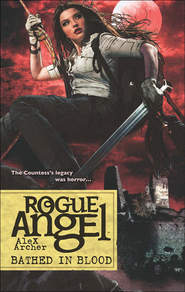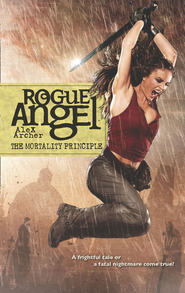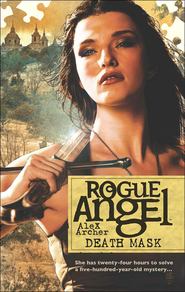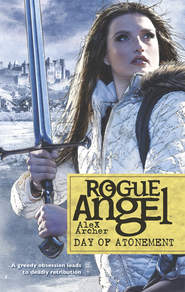По всем вопросам обращайтесь на: info@litportal.ru
(©) 2003-2025.
✖
Tear Of The Gods
Автор
Год написания книги
2019
Настройки чтения
Размер шрифта
Высота строк
Поля
Craig looked much as he did the last time she’d seen him—a bear of a man with a thick beard and a mop of unruly hair the color of pine sap. He towered over her at six and a half feet and she could have easily hidden behind his nearly three-hundred-pound body if she’d ever had the need to, but his imposing size was a complete contrast to his open and general ebullient nature.
“Now we can do some real work!” he said, a twinkle in his eyes, before crossing the space between them in that smooth gliding gait that always looked so out of character on such a large man. He wrapped her in one of his trademark hugs.
When he finally released her, and she double-checked her ribs to be certain they were all still intact, she couldn’t help but smile at him in return. One thing about working with Craig: his good humor was infectious.
“You’ve got an interesting interior decorator,” she said, nodding at the heads on the table behind her.
Her fellow archaeologist beamed. “Marvelous, aren’t they?” he said, and then stepped around her to squat in front of the center head.
“This was the first,” he said, “the one the police sent over. Isn’t it beautiful?”
His voice held a note of awe, the kind reserved for those who’ve just had some kind of religious epiphany or incredibly mind-blowing experience, and Annja almost laughed in response. She wasn’t sure that beautiful was a word she would ever use to describe a decapitated and mummified head, but it was certainly striking, she’d give him that. The victim, if that was indeed what he was, appeared to have been a male in his late twenties, maybe early thirties, with sharp cheekbones and a prominent nose. His skin had the look and appearance of well-tanned leather. His hair, still held in a ponytail with a short piece of braided rope, was a fiery orange, just short of red.
“It’s certainly something,” she replied. “I’m amazed at the level of preservation. I thought bogs were basically swamps.”
Craig nodded. “Yes and no. It depends on where they are in their development.”
He stood and faced her, doing his best to explain. “When moss dominates a low-lying section of land, the soil becomes waterlogged and acidic. Since bacteria have a difficult time surviving in such conditions, it isn’t present to break down the dead moss and other vegetation. Instead, the stuff just piles up and eventually becomes peat.”
Annja got the implication right away. “So the acidic nature of the water itself actually protects the body rather than destroying it. No bacteria means no decomposition.”
“Right,” Craig said, smiling. “And the tannins produced by the moss add an extra level of preservation, turning the skin to something like leather and keeping it from tearing in response to the pressure from above as the peat grows deeper.”
“Is that why their skin is so dark, because of the tannin?”
Craig nodded. “And why their hair is red, too.”
“You mean that lovely color isn’t natural?” she asked curiously.
“Not even close. In fact, I’m pretty sure all three of them were Romans, which means their hair was probably darker than either of ours.”
“Romans? Seriously?” She’d never heard of Romans being uncovered in a peat bog before.
“Yeah, I know, it’s unusual to say the least. But it’s hard to argue with the evidence. Here, look.” Moving to the head on the right, he reached out and turned the frame around, pointing at something on the back of the man’s skull.
At first Annja couldn’t figure out what it was, but after staring at it for a minute and mentally smoothing out the skin while doing so, she finally got it.
“It’s a tattoo, isn’t it?”
Craig’s eyes twinkled. “Yes, but a tattoo of what?”
Annja leaned in closer, trying to puzzle it out. “It’s an animal of some kind, I think. A dog, maybe? Or a wolf?”
“Close,” he replied. “Look at its mouth. See anything unusual?”
She peered at it harder, trying to sort out the details of the tattoo from the natural lines of the aged flesh. It looked like…
“Is that a tusk?” she asked without looking up.
“Right! Which makes that,” he said, pointing at the tattoo, “a wild boar.”
He beamed at her, as if the presence of the boar explained everything. But Annja wasn’t seeing the connection.
“Okay, so it’s a boar and not a wolf. So what? I still don’t see why that makes him a Roman rather than a Celt.”
Craig led her across the tent to where another table held two laptop computers and a combination printer/scanner. He sorted through a stack of papers next to one of the laptops until he found the page he was looking for and then handed it to Annja without a word.
She found herself looking at a scanned image of a battle standard photographed from a museum collection somewhere. She could even see the edge of the glass box in which it was housed. But what really caught her eye was the image of the charging boar that dominated the center of the standard. It was the exact same design that was tattooed on the back of the bog mummy’s head.
“XIV Gemina, or the Fourteenth Legion,” Craig said. “Under the command of Gaius Suetonius Paulinus, it was ordered back to Britannia by the emperor in A.D. 67 to quell the Boudican rebellion.”
Boudica was the warrior queen of the Iceni clan, Annja knew. She’d inspired and led one of the largest uprisings against Roman rule in the history of the empire. The Roman historian Cassius Dio wrote that she was “most tall, in appearance most terrifying, in the glance of her eye most fierce”—a description that made Annja smile the first time she’d read it. Annja’d been called fierce once or twice in her day, too.
She had to give Craig credit; it was a nice piece of detective work. But it raised more than a question or two in her mind. “I thought Boudica made her stand near Mancetter?” That was at least fifty miles south of where they now stood.
“She did. And that’s where the story ends for most historians. But there’s a small group, myself included, that believe a portion of her army escaped the battle that day and tried to make it to Anglesey by cutting overland across the moors. If they had, and if Paulinus pursued them as I believe that he did, then it’s not inconceivable that they met again in battle and that we’ve stumbled on evidence of that very encounter. If you examine—”
Craig’s explanation was cut short by the sound of running feet. He and Annja turned to face the entrance just as the flap was thrown open and Zeke stuck his head in through the opening.
“Dr. Stevens!” he cried, his voice full of excitement. “We’ve got another one!”
3
After delivering his message, Zeke turned and took off at a run back across the camp. Annja made as if to follow, but then hesitated. Given his size, there was no way Craig would be able to match the younger man’s pace.
He must have guessed what she was thinking, for he waved a hand at her in dismissal. “Go on! Quickly, before he’s out of sight. I’ll meet you at the excavation,” he said with a chuckle.
That was all she needed to hear. Annja was five feet ten inches tall, with chestnut hair and amber-green eyes. She had an athlete’s build, with smooth, rounded muscles and curves in all the right places, and it took her only a moment or two to sprint along until she had the eager grad student back in her sights.
She kept her eye on Zeke as he left the camp behind and moved at a quick pace through the trees for about a hundred yards, following a path worn into the earth from the passage of the dig team over the past several days. Ten minutes later Anna emerged from the trees to find herself standing on the gentle slope of a small hill, the dig site laid out before her.
The site was roughly half the size of a football field and was located in a hollow between several small hills like the one she stood on. There were two significant features that set this particular valley off from dozens of others in the nearby area. The first was a large rock cairn that had been erected at the base of the slope on which she stood, its stone face now overgrown with moss and lichen but still recognizable for what it had once been. The second was the skeletal remains of an ancient oak tree standing near the middle of the site, a jagged black scar of a lightning strike clearly visible even from a distance.
Although Craig’s team had only been here a short while, Annja could see that they’d been busy. A grid had been laid out on the valley floor in colored string, dividing the space into individual sections that Annja knew from experience were roughly two feet square. Work had begun in several sections, with the top layer of the peat removed, revealing the rich substrata beneath. Sifting stations had been set up beneath canopies to the right of the grid and there was a plethora of shovels, rakes and handheld trowels scattered about.
Most of the team was clustered around a single grid square, obviously the location of their most recent find. Annja made her way down the hill and across the dig site to join them.
The smell hit her as she moved closer, the unmistakable scent of scorched earth that accompanied a peat bog of any decent age. She resisted the urge to cover her nose; the human body only recognized an odor in the first few minutes of contact, after that it was as if it didn’t exist.
Two grad students were on their hands and knees near the corner of the grid, using hand tools to clear the debris away from the blackened face that was peeking out of the peat. While this one wasn’t as well preserved as the others, the similarities were still obvious. It was clear that the four men had the same ethnic background; the prominent nose and high cheekbones were as easy to see in this specimen as they were in the others. And like the others, this head had been severed and lay by itself in the peat that preserved it.
Who were they? Annja found herself wondering. And what happened to their bodies?
It was mysteries like these that had helped her fall in love with archaeology in the first place. She couldn’t wait to get her hands dirty.
Craig finally caught up with them then, his face red and his chest heaving from his hike through the woods, but it did nothing to stem his enthusiasm for what they’d uncovered. Being the excellent teacher that he was, Craig let his people continue unearthing the find, guiding them with encouraging comments here and there rather than taking control of the process for himself as Annja knew others she’d worked with in the past would have done. It was what made Craig such a good student of archaeology; he cared more about the artifact and what it could tell them than the academic reputation associated with whoever unearthed it.
For the next two hours Annja lost herself in the simple joy of doing what she loved, helping Craig and his students excavate the mummified head from the peat surrounding it and then carefully packing it into a foam-lined carrying case for transport back to the campsite for further examination. Several of the students recognized her from Chasing History’s Monsters and it wasn’t long before she was surrounded by a small group of her own, dispensing advice and stories of former digs just as Craig was doing with the others a few yards away. It was such a welcome relief from the recent craziness in her life that Annja found herself relaxing for the first time in weeks and enjoying the simple pleasure that came from doing something you loved in the presence of others who felt the same way.











